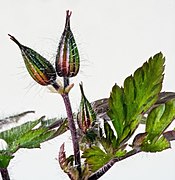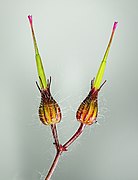Geranium robertianum
| Geranium robertianum | |
|---|---|

| |
| Scientific classification | |
| Kingdom: | Plantae |
| Clade: | Tracheophytes |
| Clade: | Angiosperms |
| Clade: | Eudicots |
| Clade: | Rosids |
| Order: | Geraniales |
| Family: | Geraniaceae |
| Genus: | Geranium |
| Species: | G. robertianum
|
| Binomial name | |
| Geranium robertianum | |
| Synonyms | |
|
Robertiella robertiana | |
Geranium robertianum, commonly known as herb-Robert,[1] or (in North America) Roberts geranium, is a common species of cranesbill native to Europe and parts of Asia, North Africa, and parts of North America.[2] The plant has many vernacular names, including red robin, death come quickly, fox geranium, stinking Bob, squinter-pip (Shropshire) and crow's foot.
Description
[edit]
Herb Robert is a small, usually biennial but sometimes annual or even short-lived perennial herb that typically grows to about 30 cm (1 ft) tall and broad, or sometimes up to about twice that size. Young plants have a very short vegetative stem with effectively a basal rosette of leaves on long (2-5 cm) petioles, while older plants put up flowering stems from the axils of one or more of these basal leaves. The flowering stems can arise vertically or sprawl along the ground, and some of them can turn into stolons by putting down roots at the nodes. The whole plant is variously hairy, with a mixture of long simple hairs and shorter gland-tipped hairs. The fresh plant has a strong unpleasant odour when bruised or uprooted, but this property fades with time. Its colour can vary from entirely green, to reddish at the nodes or on the stems or leaves, or the whole plant (except the petals) can be bright red, especially when growing in bright sunshine.

The leaves are arranged alternately along the stems, and are typically divided into three stalked lobes, the lower two of which are further split to produce a 5-lobed (palmate) outline, up to about 11 cm in diameter in the largest, lower leaves. The leaflets are deeply lobed and toothed, and end with a short mucronate tip.

Flowering occurs from early spring to late autumn in northern Europe and plants remain green over winter. The inflorescence is on a long peduncle which arises opposite a leaf on the flowering stem, and consists of a pair of bisexual pink flowers, 12-16 mm in diameter, on short (1 cm) pedicels. Often one of the two flowers in a pair will be abortive. The five sepals are about 5 mm long, lanceolate and are covered with both pink-tipped glandular and eglandular hairs. The petals are from 8 to 14 mm long, purplish-pink with white stripes, and with the claw slightly shorter than the limb. There is no notch in the top of the petals, unlike in some other geraniums. There are 10 stamens in two rings of 5 that project slightly beyond the flower, with purple anthers and yellow pollen; the inner ring of anthers open first. The female part of the flower consists of 5 carpels with one style, which is divided into 5 pink stigmas at the top. These are already spread when the flower opens, which facilitates self-pollination, although cross-pollination also occurs.
The fruit is a schizocarp, which splits into 5 mericarps on maturity. These are situated at the base of the style, which elongates as the fruit develops. Connecting the tip of the style to the mericarp is a strip of material called an awn. When the fruit is ripe, the awn curls upwards explosively from the base, ejecting the fruits a distance of a metre of so from the parent plant.[3][4][5]
Identification
[edit]Other cranesbills that look rather similar include shining cranesbill, which has lobed but undivided leaves, and long-stalked cranesbill, which has long points on the sepals. It is very similar in appearance to little robin but that species has smaller flowers (5-9 mm) and yellow anthers.
Taxonomy
[edit]The scientific name was assigned by Linnaeus in Species Plantarum volume 2, p. 681 (1753), and it has not changed since then; but it was not original. Linnaeus cites Bauhin having used the polynomial Geranium robertianum primum it in his Pinax theatri botanici in 1623, who in turn credited Dodoens as having used the name Geranium robertianum in his Stirpium historiae in 1554 (vol. 1, p. 62).
The generic name comes from the Ancient Greek word for the plant, γεράνιον (géranion), which originated from γέρανος (géranos) 'crane' with the diminutive ending -ιον, "little crane". This was also used by the Romans.[6] It refers to the beak-like shape of the style in fruit. The origin of the specific epithet robertianum is unclear. Botanical names do not have any intrinsic meaning.
The English common name "Herb Robert" is simply an anglicisation of the scientific name.
There are many synonyms of Geranium robertianum, most of them having arisen as descriptions of varieties or subspecies. These are not widely accepted now. A full list is given in Plants of the World Online. Some experts, however, do still recognise various forms. Sell & Murrell,[4] for example, describe three subspecies in Britain:
- subsp. celticum Ostenf., a green-coloured annual with pale flowers, found on limestones in the west;
- subsp. maritimum (Bab.) H.G. Baker, a prostrate red biennial with dark flowers, found on shingle beaches;
- subsp. robertianum, the common form found inland.
Geranium robertianum has a chromosome number of 2n = 32 or 64.
Distribution and habitat
[edit]Its main areas of distribution are Europe from the north Mediterranean coast to the Baltic, from the British Isles in the west to the Caucasus in the east, and eastern North America.[7] It is not native to western North America, where it has escaped from cultivation and is regarded as an invasive species.[8] Geranium robertianum is common throughout Great Britain and Ireland in woodland, hedgerows, scree and maritime shingle.[5] It grows at altitudes from sea level to 710 metres (2,329 ft) in Teesdale, England and above 2,100 metres (6,890 ft) in parts of mainland Europe on calcareous alpine screes.[9]
Uses
[edit]Herb Robert has been used in the folk medicine of several countries, including as a treatment for diarrhea, to improve functioning of the liver and gallbladder,[10] for toothache and nosebleeds,[11] and as a vulnerary (used for or useful in healing wounds).[12] Its common name has several possible sources: the Latin word for red, ruber; Shakespearean character Robin Goodfellow, the mischievous hobgoblin in A Midsummer Night's Dream; an early duke of Normandy named Robert who is rumored to have commissioned the Regimen sanitatis Salernitanum; or abbot and herbalist Robert of Molesme.[13][14] Freshly picked leaves have an odor resembling burning tires when crushed, and if they are rubbed on the body the smell is said to repel mosquitoes.[12]
Chemical constituents include tannins, a bitter compound called geraniin, and essential oils.[15]
-
Typical leaf structure
-
Flower buds
-
fruits
-
Blossom and bud
References
[edit]- ^ BSBI List 2007 (xls). Botanical Society of Britain and Ireland. Archived from the original (xls) on 2015-06-26. Retrieved 2014-10-17.
- ^ Kartesz, J.T. "BONAP's Taxonomic Data Center (TDC): North American Vascular Flora". The Biota Of North America Program. Retrieved 19 September 2021.
- ^ Tofts, Richard J. (2004). "Geranium robertianum L." Journal of Ecology. 92 (3): 537–555. doi:10.1111/j.0022-0477.2004.00892.x. ISSN 0022-0477.
- ^ a b Sell, Peter; Murrell, Gina (2009). Flora of Great Britain and Ireland, vol. 3. Cambridge: Cambridge University Press.
- ^ a b Stace, C.A. (2019). New Flora of the British Isles (4th ed.). Suffolk: C&M Floristics. ISBN 978-1-5272-2630-2.
- ^ Dioscorides P. "De Materia Medica" (PDF).
- ^ "Geranium robertianum L." Plants of the World Online. Royal Botanic Gardens, Kew. Retrieved 15 March 2023.
- ^ "Herb Robert identification and control: Geranium robertianum - King County".
- ^ Tofts, R.J. (2004), "Biological flora of the British isles No. 234 Geranium robertianum L", Journal of Ecology, 92 (3): 537–555, doi:10.1111/j.0022-0477.2004.00892.x
- ^ "Herb Robert: Uses, Side Effects, Interactions, Dosage, and Warning". www.webmd.com. Retrieved 2019-09-22.
- ^ Foster, Steven (2006), Desk Reference To Nature's Medicine, Washington, DC: National Geographic Society, pp. 210–11, ISBN 0-7922-3666-1
- ^ a b Milliken, W.; Bridgewater, S. (2004), Flora Celtica, Edinburgh, U.K.: Birlinn Ltd., p. 221, ISBN 1841583030
- ^ Herb Robert (Geranium robertianum), 2011, retrieved 12 June 2022
- ^ Herb-Robert (Geranium robertianum), retrieved 12 June 2022
- ^ "Herb Robert – Herbs are Special". Retrieved 2024-05-05.
Bibliography
[edit]- Blanchan, Neltje (2005), Wild Flowers Worth Knowing, Project Gutenberg Literary Archive Foundation
- Isabell Shipard (2003), How can I use HERBS in my daily life?
- Peter Loewer (1991), The Wild Gardener




